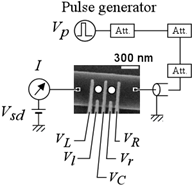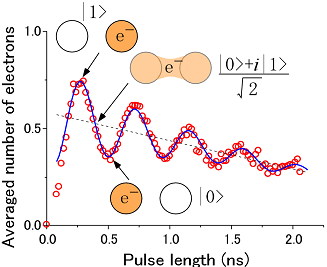Physical Science Laboratory
The study of quantum computing has attracted great attention because it
is more efficient at some specific calculations than classical computing.
The elementary unit of quantum computing (qubit) has two quantum states which
are taken as a set of basis states (|0> and |1>). Unlike a classical
bit, any state of a qubit which represents quantum information can be described
as a linear combination of the two basis states. Quantum information processing
devices are required to perform universal unitary gate operations within the
decoherence time of the qubits. Although much effort has been invested, the
experimental realization of quantum computing is still challenging.
We have studied a charge qubit in a semiconductor double quantum dot (QD)
because all parameters we need for unitary gate operations can be controlled
electrically [1]. The double QD consists of two QDs coupled to each other
via a tunnel barrier and electrons can flip back and forth between the two
QDs. For simplicity, we consider that we have one electron in the double QD.
The two states of the charge qubit are the states in which the electron occupies
one of the two QDs.
We employed a lateral double QD fabricated from a GaAs / AlGaAs heterostructure,
as shown in Fig. 1. A voltage pulse is applied to the drain electrode to modify
the electronic state of the double QD abruptly. This non-adiabatic transition
allows us to perform initialization, coherent manipulation, and read-out operations
of the qubit state. We have also demonstrated rotation gate operation [1]
and phase-shift gate operation [2] on the charge qubit at 20 mK.
Figure 2 shows the normalized current through the device, which can roughly
be taken as the averaged number of electrons in the right QD at measurement
operation. This shows an oscillating behavior as a function of pulse length,
which corresponds to rotation gate operation. We also showed that it was possible
to change the oscillation frequency, which is related to the coupling energy
between the two QDs, by changing the gate voltages.
The present result is the first step towards physical realization of quantum
computing.
[1] T. Hayashi et al., Phys. Rev. Lett. 91 (2003) 226804.
[2] T. Fujisawa et al., Physica E, in press.
 |
 |
||||
|
|